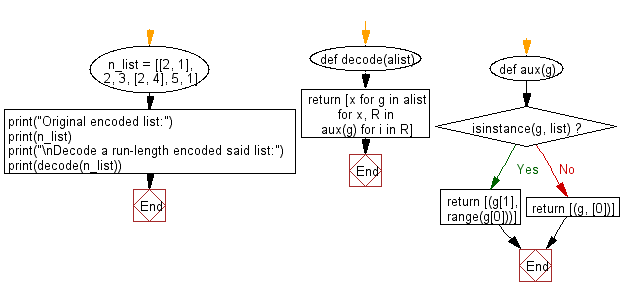Python: Decode a run-length encoded given list
Python List: Exercise - 77 with Solution
Run-length encoding (RLE) is a form of lossless data compression in which runs of data (sequences in which the same data value occurs in many consecutive data elements) are stored as a single data value and count, rather than as the original run.
Write a Python program to decode a run-length encoded given list.
Sample Solution:
Python Code:
def decode(alist):
def aux(g):
if isinstance(g, list):
return [(g[1], range(g[0]))]
else:
return [(g, [0])]
return [x for g in alist for x, R in aux(g) for i in R]
n_list = [[2, 1], 2, 3, [2, 4], 5, 1]
print("Original encoded list:")
print(n_list)
print("\nDecode a run-length encoded said list:")
print(decode(n_list))
Sample Output:
Original encoded list: [[2, 1], 2, 3, [2, 4], 5, 1] Decode a run-length encoded said list: [1, 1, 2, 3, 4, 4, 5, 1]
Flowchart:

Visualize Python code execution:
The following tool visualize what the computer is doing step-by-step as it executes the said program:
Python Code Editor:
Have another way to solve this solution? Contribute your code (and comments) through Disqus.
Previous: Write a Python program to create a list reflecting the run-length encoding from a given list of integers or a given list of characters.
Next: Write a Python program to split a given list into two parts where the length of the first part of the list is given.
What is the difficulty level of this exercise?
Test your Programming skills with w3resource's quiz.
Python: Tips of the Day
Find current directory and file's directory:
To get the full path to the directory a Python file is contained in, write this in that file:
import os dir_path = os.path.dirname(os.path.realpath(__file__))
(Note that the incantation above won't work if you've already used os.chdir() to change your current working directory, since the value of the __file__ constant is relative to the current working directory and is not changed by an os.chdir() call.)
To get the current working directory use
import os cwd = os.getcwd()
Documentation references for the modules, constants and functions used above:
- The os and os.path modules.
- The __file__ constant
- os.path.realpath(path) (returns "the canonical path of the specified filename, eliminating any symbolic links encountered in the path")
- os.path.dirname(path) (returns "the directory name of pathname path")
- os.getcwd() (returns "a string representing the current working directory")
- os.chdir(path) ("change the current working directory to path")
Ref: https://bit.ly/3fy0R6m
- New Content published on w3resource:
- HTML-CSS Practical: Exercises, Practice, Solution
- Java Regular Expression: Exercises, Practice, Solution
- Scala Programming Exercises, Practice, Solution
- Python Itertools exercises
- Python Numpy exercises
- Python GeoPy Package exercises
- Python Pandas exercises
- Python nltk exercises
- Python BeautifulSoup exercises
- Form Template
- Composer - PHP Package Manager
- PHPUnit - PHP Testing
- Laravel - PHP Framework
- Angular - JavaScript Framework
- Vue - JavaScript Framework
- Jest - JavaScript Testing Framework
